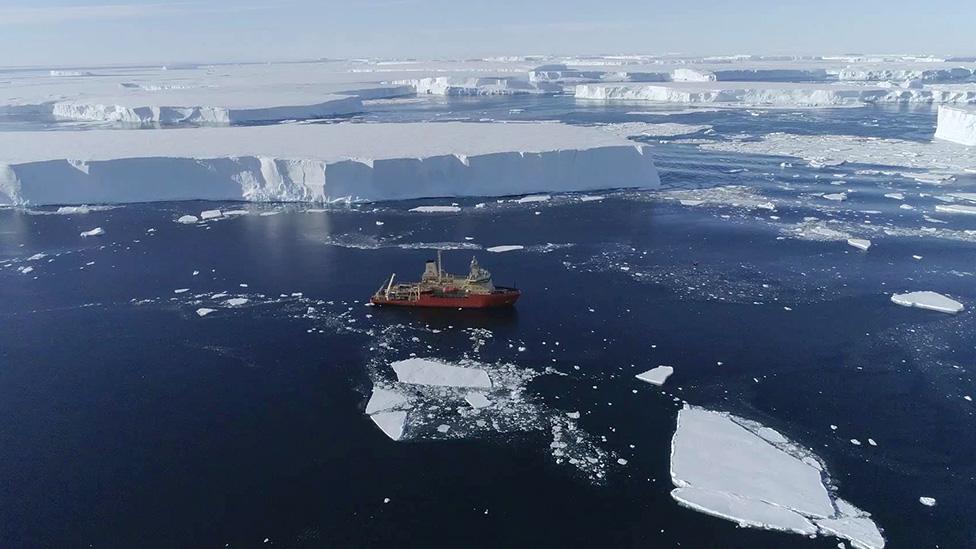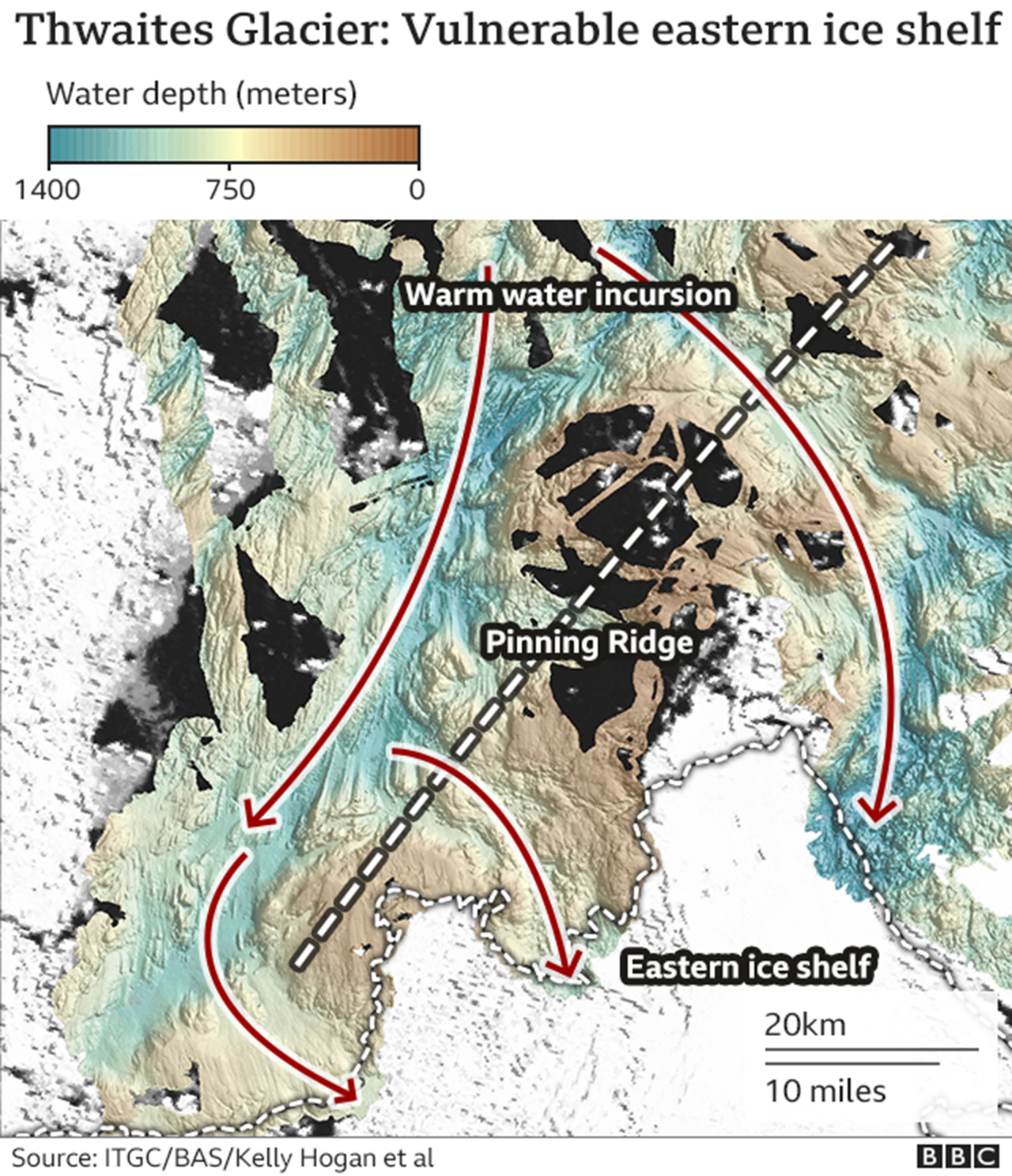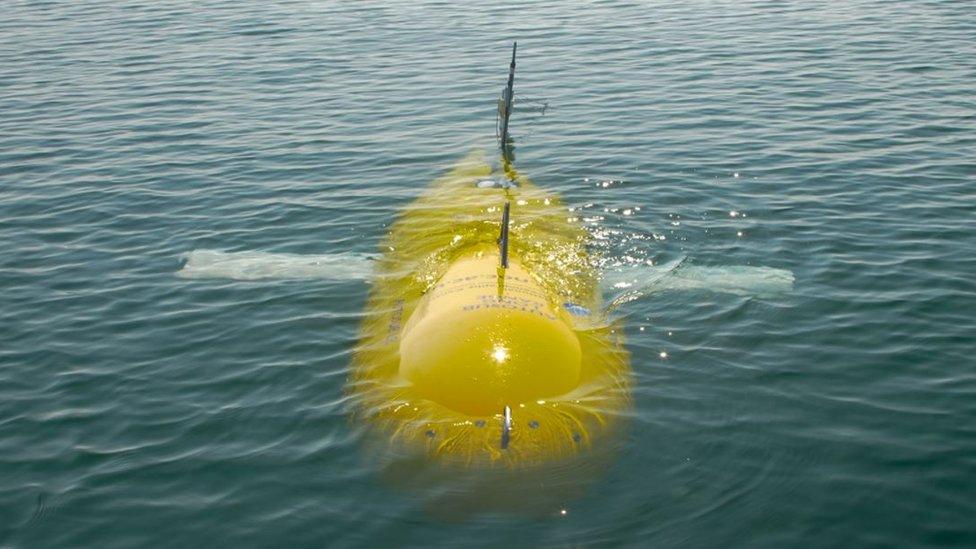Thwaites: Antarctic glacier heading for dramatic change
- Published

Thwaites is so wide, it goes to the horizon in all directions
Scientists are warning of dramatic changes at one of the biggest glaciers in Antarctica, potentially within the next five to 10 years.
They say a floating section at the front of Thwaites Glacier that until now has been relatively stable could "shatter like a car windscreen".
US and UK researchers are currently engaged in an intense study programme at Thwaites because of its melt rate.
Already it is dumping 50 billion tonnes of ice into the ocean each year.
This is having limited impact on global sea-levels today, but there is sufficient ice held upstream in the glacier's drainage basin to raise the height of the oceans by 65cm - were it all to melt.
Such a "doomsday" scenario is unlikely to come about for many centuries, but the study team says Thwaites is now responding to a warming world in really quite rapid ways.
"There is going to be dramatic change in the front of the glacier, probably in less than a decade. Both published and unpublished studies point in that direction," said glaciologist Prof Ted Scambos, US lead coordinator for the International Thwaites Glacier Collaboration (ITGC), external.
"This will accelerate the pace (of Thwaites) and widen, effectively, the dangerous part of the glacier," he told BBC News.

Thwaites is a colossus. It's roughly the size of Great Britain, or Florida, and its outflow speed has doubled in the past 30 years.
The ITGC has established how this is happening. It is the result of warm ocean water getting under - and melting - Thwaites's floating front, or ice shelf as it's known.
The warm water is thinning and weakening this ice, making it run faster and pushing back the zone where the main glacier body becomes buoyant.
At the moment, the leading edge of the eastern ice shelf is pinned in place by an offshore underwater ridge, which means its flow speed is a third of that seen in the ice shelf's western sector which has no such constraint.
But the ITGC team says the eastern shelf is likely to become uncoupled from the ridge in the next few years which will destabilise it. And even if the pinning persists, the ongoing development of fractures in the shelf ice will almost certainly break up the area anyway.
Our Climate Editor Justin Rowlatt visited Thwaites in 2020
"I visualise it somewhat similar to that car window where you have a few cracks that are slowly propagating, and then suddenly you go over a bump in your car and the whole thing just starts to shatter in every direction," explained Dr Erin Pettit from Oregon State University, external.
The affected area is very small when considered in the context of the glacier as a whole, but it is the shift to a new regime and what this means for further ice loss that is the real significance.
At present, the eastern shelf, which has a width of about 40km, moves forward at about 600m per year. The coming change in status will probably see the following ice jump in speed to about 2km per year - the same as the current velocity recorded in the 80km-wide western sector.
Jointly funded by the US National Science Foundation and the UK's Natural Environment Research Council, the five-year ITGC project is putting Thwaites under unprecedented scrutiny.
Each Antarctic summer season, teams of scientists are investigating the glacier's behaviour in every way possible. From satellite, on the ice, and from ships in front of Thwaites.
Those teams are en route for the new season right now, some in Covid quarantine ahead of their deployment to the field.

Boaty McBoatface, the British Autonomous Underwater Vehicle, will dive under Thwaites' ice shelf
One of the projects for the New Year will see the tubby yellow submarine known as "Boaty McBoatface" dive under Thwaites' floating ice to gather data on water temperature, current direction and turbulence - all factors that influence melting.
The autonomous vehicle will go on missions lasting one to four days, navigating its own path through the cavity beneath the shelf. This is high risk as the seafloor terrain is extremely rugged.
"It's scary. We might not get Boaty back," conceded Dr Alex Phillips from the UK's National Oceanography Centre.
"We've put a lot of effort this past year into developing collision avoidance for the vehicle, to make sure it doesn't crash into the seabed. We also have contingencies whereby if it does get into trouble, it can retrace its steps and retreat to safety."
The latest science on Thwaites Glacier is being presented this week at the American Geophysical Union Fall Meeting in New Orleans, external.
